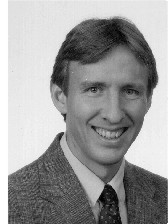

Todd Hubing
Associate Editor
Art Glazar, a Life Senior Member of the IEEE EMC Society, sent in the following EMC limericks:
Looking up from my scope I declared,
To my client whose face was despaired,
“Your prototype sucks”
“But for eight hundred bucks”
“And some ferrites it can be repaired.”
There was a young man from T.I.
who suffered a mote in his eye;
When his pain had subsided,
To his boss he confided,
“It’s less painful than this EMI.”
Thanks, Art! Art’s limericks and others can be found on the web at https:// www.emcs.org/limericks.html. If you would like to contribute to our EMC limerick collection, email your contribution to me at t.hubing@ieee.org.
Did you solve the puzzle in the last Chapter Chatter column? Did you notice there were actually three messages? I didn’t think so. If you took the time to find the first message, you probably stopped there. EMC engineers are generally in the fix-it-and- get-it-out-of-here mode. Once a problem is solved (i.e. the product passes), they move on to the next crisis. You can find all three solutions to the puzzle by visiting the IEEE EMC Society’s web page at https://www.emcs.org. Click on the “Chapters” button, then in the list of “Chapters with Web Sites,” click on the city that doesn’t actually have an EMC Society chapter. This will bring you to the secret web page containing both the puzzle and its solutions.
Was the puzzle in the last issue too hard? Did you spend many fruitless hours trying to solve it? If so, here’s another puzzle for you.
If u cn rd ths, thn u cn b n ngnerng mgr.
If you have trouble with this one, ask one of your subordinates for help.
Thanks to Bruce Crain, chair of the Atlanta chapter, for submitting the following report. Bruce will soon be moving to “sunnier pastures” in Melbourne, Florida. David Dennis will be the new chair of the Atlanta Chapter. Good luck to both Bruce and David.
The Atlanta EMCS chapter held a meeting on March 23, 1999 at the Lockheed Martin Aeronautical Systems (LMAS) facility in Marietta, Georgia. The speaker was John Osburn, who has recently joined the Electromagnetic Environmental Effects group at LMAS. Mr. Osburn presented “Evaluating and Improving Radiated Immunity Test Systems Performance.” After presenting the textbook nuts-and-bolts of how to put together a radiated immunity test system, Mr. Osburn gave the “real story” of how to specify components to account for antenna calibration distances, amplifier linearity, and signal modulation effects. He also gave us the benefit of his experience in the field by discussing practical issues such as signal generator non-ideal characteristics, signal generator switching characteristics and E-field probe response.
Vil Arafiles reports that the Baltimore chapter has a new web page that is accessible from the IEEE Baltimore Section web page at https://www.ewh.ieee.org/r2/baltimore. The page contains announcements for new meetings and current officers. The Baltimore chapter will announce future meetings on this web site and provide e-mail reminders to members who provide e-mail addresses. Postal mail notices will continue to go out to all members who do not have internet access. It is hoped that this move will dramatically reduce operating costs, as mailings comprise more than 75% of the budget.
The 1999 officers are:
Mr. Fred Kirby of EMC Technologist, Chairman; e-mail: fred2@shore.intercom.net
Mr. John Anderson of IITRI, Vice Chairman
Mr. Charles W. Gaston, e-mail: cwg3@juno.com
Ms. Angela J. Johnstone of IITRI; e-mail: Ajohnstone@iitri.org
The February meeting of the Central New England chapter featured a talk on “Telecom Circuit Safety: The Interpretation and Implementation of EN60950 Clause 6, Connection to Telecommunication Networks” by Daniel C. Clarkson of BABT Product Service. The rapid growth in telecommunications technology and the Internet has insured that almost all Information Technology Equipment (ITE) has a connection to the Product Service Telecommunication Network (PSTN). However, connections to the PSTN present unique challenges to the design and compliance communities, one of which is interpreting and implementing the requirements of Clause 6 of EN60950 (which may include unique national requirements).
On December 7, a successful meeting of the Central and South Italy Chapter was held in Rome. The General Vice-Director of the Environment Ministry, Dr. Biondi, gave a Seminar on the new law (Nov. 1998) regulating the levels of electromagnetic field in the high frequency range (above 100 kHz), in Italy. These limits will be effective beginning in January 1999. Also, the evolving situation in the EC was clarified and presented. More than 100 hundred people attended the conference. The 90-minute presentation was followed by many questions.
Prof. Heyno Garbe reports that an International Symposium on Electromagnetic Compatibility will be held together with the German IEEE EMC Chapter at the Otto-von-Guericke-University Magdeburg in Magdeburg, Germany from 5 to 7 October 1999. For the Call for Papers, Author’s Schedule, Topics, Commercial Exhibitions, and further information, please visit the web page at https://iele96.et.uni-magdeburg.de/EMC-MD. While you’re at it, you can also visit the new chapter web site at https://www.geml.uni-hannover.de/grund_elektr/mitarbeiter/ieee/ieee.html.
The newest IEEE EMC Society chapter is in Korea. Dong Chul Park is the new chapter chair. This year the Korea Chapter will conduct one or two technical meetings and co-sponsor several EMC-related symposia held in Korea. For more information you can contact Prof. Park (dcpark@hanbat.chungnam.ac.kr).
At the October 1998 Meeting, John Osburn spoke on EMC antennas and their applications. Mr. Osburn was kind enough to make a special trip from Austin just to join the Orange County Chapter for this presentation. All of the attendees (over 25 of them) left the meeting with a little more understanding of EMC antennas and how to use them effectively.
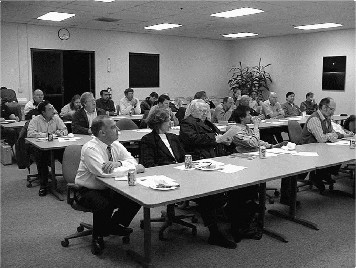
Over 30 EMC professionals attended the
Orange County Chapter’s February meeting, among them –
Well-known EMI Guru Mike King.
At the December meeting, a special presentation was given on the Broadband Gigahertz Field Simulation Chamber. The information presented by Jozef Baran of AST Research and Mark Frankfurth of Cymer Laser Technologies indicated that the BGF Chamber could very well replace Anechoic chambers, GTEM Cells, and even Open Area Test Sites for EMC and EMI testing. The topic was very well received, with lots of questions for the speakers asked by the audience. Over 25 people attended this meeting, although it is not clear if they came for the presentation or the gourmet Italian meal.
The February,1999 meeting of the Orange County Chapter of the EMC Society featured Douglas Smith of Auspex Systems. Mr. Smith presented a very entertaining talk on Unusual and Hidden forms of Electrostatic Discharge. Covering some of his entertaining experiences in the past, his demonstrations and ESD Mitigation war stories kept the thirty attendees smiling and laughing, while dining on chicken, rice and valentines cookies.

Speaker Doug Smith entertained the crowd with a demonstration of an
unusual source of Electrostatic Discharge Disturbances. Doug is shown
shaking a bag of change in front of an ESD sensor, with surprising results.
The Orange County Chapter is sponsoring a one-day tutorial on October 4th, 1999. The tutorial, called “EMC Fest ‘99”, will feature such reknowned speakers as Dr. Howard Johnson, Mr. Lee Hill, and Mr. Daryl Gerke. So, mark your calanders! You don’t want to miss this one! For more information, please contact the Chapter Chair, Randy Flinders, at (714) 513-8012, or at r.flinders@ieee.org.
The February meeting of the Phoenix Chapter of the IEEE EMC Society featured Pat Malloy of Amplifier Research speaking about RF Immunity Testing. He provided a general update of the EU requirements, followed by specific details on RF immunity testing. Issues discussed included “Real Time” leveled loop testing versus “Substitution” methods (also known as pre-calibration without the EUT present). Mr. Malloy also provided information on power amplifier compression, harmonics, VSWR effects on output power, directional coupler basics, antenna concerns, and device monitoring.
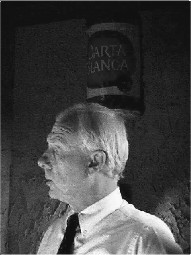
Pat Malloy of Amplifier Research is shown
explaining various methods of
radiated immunity testing.
The twenty attendees at the meeting confirmed unanimously the three individuals railroaded/nominated for Chairman, Vice-Chairman, and Secretary/Treasurer. These individuals will serve a one-year term and include:
Chairman
Terry Donohoe, terry.donohoe@cas.honeywell.com
Vice-Chairman
Daryl Gerke, dgerke@emiguru.com
Secretary/Treasurer
Harry Gaul, p19850@email.mot.com
Although the Phoenix chapter is only several months old, we’ve already created a web page at https://www.ewh.ieee.org/r6/phoenix/phoenixemc/. Stay tuned to the web page for upcoming meeting notices! Also, the Phoenix chapter is presenting an EMC Colloquium and Exhibition on May 3 at the DoubleTree - La Posada Resort in Scottsdale, AZ. We hope to see many of the EMC’ers from Arizona, California, and New Mexico at the colloquium!
Thanks to Lyle Luttrell, chair of the Rocky Mountain chapter, for sending in the following chapter update.
The Rocky Mountain Chapter is off to a great start on our 1999 program. A strong turnout for our February 16 meeting confirmed that our chapter program vision is “on-track” with plans to bring more valuable EMC training opportunities to the regional community.
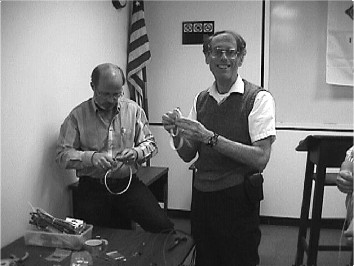
Doug Smith provides advice on calibration of the probe to RMC
members including
Rich Gonzales, Matt Aschenberg, Chas Grasso, Otto Buhler,
“Rip” Van Winkle, Forest Dillenger and Tim Groat.
A total of 35 people, including 10 non-members, ate their fill of pizza sponsored by EMC Integrity for lunch, then filled the meeting room at NIST in Boulder for a presentation by Doug Smith, EMC Manager of Auspex Systems Inc. Doug is well known for presentations that bring out the fundamentals of EMC measurements in an understandable and affordable manner. The topic of the meeting was “High Frequency Signal Measurement and Probe Building”. Doug lead with an hour of background in high frequency signal integrity measurement using scope probes, covering some of the pitfalls and limitations of probing as well as solutions to common measurement problems. As Doug explained the shortcomings of conventional probes, he presented a probe design that avoids these problems, and can be constructed using materials that cost only a few dollars.

Mark Moyer and Scott Gurst of Exabyte Corporation produced the best
performing probe with a frequency response better than 1dB from DC - 1GHz!
After the talk, materials were provided for attendees to build their own calibrated 1 GHz passive 20X probes; the materials for 30 probes cost about $100. With Doug’s expert guidance, most attendees built a probe before leaving the meeting, while others took parts and instructions to do it at home. Eight assembly stations and one calibration station provided by StorageTek and Breece Hill were busy for the afternoon. The “best” probe was better than 1dB from DC to 1GHz! Several members report they are using the new probes on a daily basis.
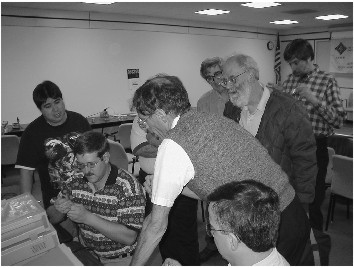
Doug Smith and Rick Hansen hand out parts kits for
building probes at the RMC meeting.
February meeting attendees also completed a program survey. The results are providing the executive committee with useful information for planning future chapter meetings. Our Chapter website continues to be updated often to include information on meeting announcements and program information for the Rocky Mountain Chapter, plus links to other sites for EMC engineers. The URL is https://www.ewh.ieee.org/r5/denver/rockymountainemc/.
The Santa Clara Valley chapter is in full swing with new officers, meeting location, format of presentation and more job opportunities available than engineers looking for work. Typical meetings attract a minimum of 75 engineers and guests, with some meetings reaching up to 120 attendees. Due to problems in the past with meeting locations throughout Silicon Valley, we finally settled into Auspex Systems in Santa Clara, courtesy of Doug Smith.
The technical program for the 1998-1999 calendar year was developed by vice-chairman Zorica Pantic-Tanner. Our last six meetings are reported herein.
We began our new year with a dinner meeting in September at a local restaurant, the same location where we have been holding this planning session for over 10 years. This gave us the opportunity to talk about the symposium in Denver, plus to catch up on gossip from our summer break. The only business conducted at our monthly meetings, beside the guest speaker, is to have companies with job openings make an announcement (usually five opportunities or more per month), and for those seeking employment to speak-up (almost never).
Our first technical meeting of the year began in October with Dr. Jose Perini, IEEE EMC Society Distinguished Lecturer. The topic was “Radiated and Injected Tests - When are They Equivalent?” This was well attended with considerable discussion on various aspects of the topic. When the Q&A session started, it was easily determined who specialized in the mathematics of testing.
November’s meeting was quite enjoyable when Diethard Moehr of Siemens AG was the guest speaker. His topic was “EMC in the European Union.” During the presentation, we learned things that are not readily known to EMC engineers, much less the marketplace. Diethard’s ability to provide humor kept attendees for well over 2-1/2 hours. Items discussed included measures US manufacturers can take now and in the future to simplify the EU EMC compliance process, including the European EMC Directive and national EMC laws. In addition, legal requirements on EMC emission and immunity testing in the Europe was presented, including how to test modules, apparatus, systems, installations and guidelines on the application of the EMC Directive. The interesting part was hearing how European companies buy their competitor’s products, have them tested, and then report non-conformity to the authorities, along with real-life examples. Also, secrets were shared on how the authorities actually perform audit testing and the criteria for passing or fining (includes failing) companies. Over 100 attendees were present.
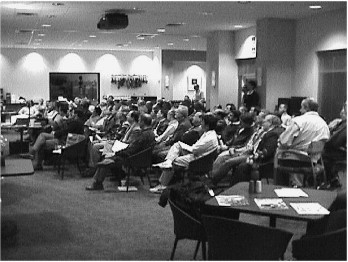
The meeting location for the Santa Clara Valley chapter at Auspex Systems.
Only in Silicon Valley can one learn about new technology being designed for use in testing products. Neven Pischl of Bay Networks discussed “A New Common-Mode Voltage Probe for Predicting EMI from Unshielded Differential-Pair Cables” in December. Not only were colored handouts on high-gloss paper provided, instrumentation was used to demonstrate a probe developed at Bay Networks (patent pending) using an Ethernet hub, spectrum analyzer, and support equipment. This common-mode probe, plugged into an RJ45 Ethernet port, provides insight into various design concerns, measuring common-mode energy presented within this I/O cable interconnect. Again, a large turnout was present. The probe was, unfortunately, “not” for sale at the meeting!

Neven Pischl of Bay Networks is shown setting up equipment
to demonstrate his “common-mode probe”.
The January meeting hosted Don Bush of dBi Corporation and IEEE EMC Society Distinguished Lecturer on “Spread Spectrum Clock Techniques.” Mr. Bush, one of the founders of spread spectrum technology, presented the historical background on how this technique was discovered, the pains in getting the FCC to accept this technology, and the advantage/disadvantage of use. Attendance was 120, one of the largest gatherings we have had in several years.
In February, Robert Dockey, another IEEE EMC Society Distinguished Lecturer, presented “New Techniques for Reducing PCB Radiation” to an audience of 115 attendees. A lively question and answer session followed, with numerous technical questions, much to Bob’s enjoyment. The Santa Clara chapter is a tough, but fun group to present papers to.
Our March meeting had 85 attendees hear David Pommerenke of HP, Roseville, CA, give a presentation on “Conducted Immunity IEC 61000-4-6.” David brought numerous clamps and probes to illustrate problems within the standard, alternate methods of testing, and solutions to test configurations in order to meet the intent of the directive.

Engineering prototype “common-mode probe” Patent pending – not for sale, yet.
Future meetings will include for April 13th “Solving Real World EMC Problems using the FDTD Modeling Code” by Dr. Gary Haussmann, Silicon Graphics Inc. and on May 11, “San Francisco State University Recent Research on EMC.”
The chapter kicked off the new year with Dick Ford as the speaker at its January meeting. Complimentary pizza and soft drinks were provided by CKC Laboratories, at whose Redmond facility the meeting was also held. Dick is a member of the EMC Society Board of Directors, a NARTE certified EMC engineer and an independent E3 consultant. The presentation was entitled: “The Navy/NAVAIR Model Program (NPFE) for EMC Excellence.” Dick gave an historical review of where EMC was in the Navy and the roots of the program that has, among other things, resulted in a number of us adding the letters “NCE” or “NCT” after our names. It was an informal, interactive presentation which chapter members greatly enjoyed. A surprise guest, Russ Carstensen, was present to add a unique perspective to the discussion as he was involved in the formative days of the program. Russ is a long-time member of the NARTE Board of Directors and his comments were truly appreciated by the chapter members.

At the January Seattle Chapter meeting, (L-R) Speaker Dick Ford is
warmly greeted by Pat Andre of CKC Labs, the meeting host, and Ghery Pettit of Intel,
the chapter chairman. Dick's presentation on the "Navy/NAVAIR Model Program for
EMC Excellence" drew a surprise guest, Russ Carstensen, a NARTE Director.
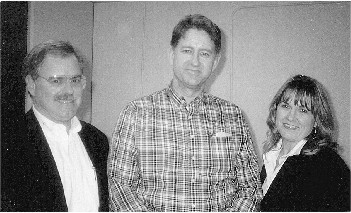
(L-R) Mike Caruso of Underwriters Laboratories, Mark Chase of CKC
Labs and
Christie Bishop of EMC Technology Services chatted at the January Seattle Chapter meeting.
Mike was in the area from Northbrook, Illinois and Christie came from Fremont, California.
They planned ahead and combined a business trip with a visit to the chapter meeting.
All "out-of-towners" are welcome to attend the Seattle Chapter meetings!
In February, Hans-Peter Bauer of Rohde and Schwarz spoke on the topic “Speeding Up EMI Measurements”. Hans-Peter explained that minimizing the total measurement time is an important goal of automated emission measurements. Special attention was given to the proper detection and measurement of all kind of disturbances: both continuous and intermittent narrowband as well as broadband disturbances. Hans-Peter led a discussion on minimum measurement times, including strategies for pre-scan and data reduction. In his introduction of the speaker, Chairman Ghery Pettit advised that Hans-Peter worked as a sales and application engineer for Rohde and Schwarz-Germany, where he focused on EMC solutions. Since the beginning of 1998, Hans-Peter has been working at the Marketing and System Support Center of Rohde and Schwarz-America in Beaverton, Oregon. This explains his nice accent! Chapter members enjoyed complimentary pizza prior to the meeting courtesy of chapter supporter Lindgren RF Enclosures. Yum!
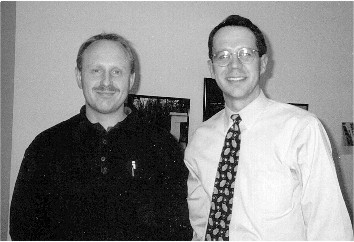
Hans-Peter Bauer of Rohde and Schwarz (L) was the charming speaker
at the
February Seattle Chapter meeting. Everyone appreciated his accent as well as
his insightful presentation. He was joined by Ben Hess, the local
sales representative for Tektronix/Rohde and Schwarz.
At the March chapter meeting, Joe Butler, Market Manager, Chomerics Division of Parker Hannifin Co., presented: “Shielding Effectiveness - Why Don’t We Have Consensus Industry Measurement Standards.” Joe explained that EMC engineers involved in the design or procurement of shielded enclosures and/or related shielding components must be especially vigilant about published technical specifications in the area of shielding effectiveness. Further, Joe advised that this is especially true regarding the test methods for EMI shielding effectiveness. Despite the existence of published consensus standards from organizations such as IEEE, ASTM, and SAE, the existing standards are not uniformly embraced by manufacturers who publish technical specifications. Two manufacturers marketing the same product will often use completely different specification test methods. Still others will modify an existing standard method without fully disclosing the modification. The presentation reviewed current industry shielding effectiveness test methods for shielded rooms, as well as floor standing and tabletop shielded enclosures. Shielding effectiveness test methods for conductive paints and coatings, shielded windows, shielded air ventilation panels, and EMI gasketing were also reviewed. Joe concluded his presentation by emphasizing the need for industry accepted consensus shielding effectiveness measurement standards.
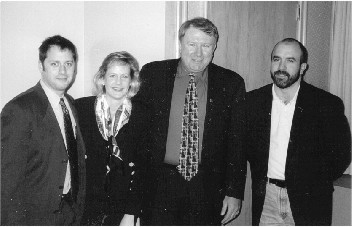
At the March Seattle Chapter meeting, Joe Butler of the Chomerics
Division of
Parker Hannifin gave a stellar presentation on the status of EMI standards as
related to shielding components and table-top enclosures, among other products.
Joe proved he's got the "right stuff" to be the next President of the EMC
Society!
(L-R) Todd Sousa, the local Chomerics Territory Sales Manager,
joined Janet O'Neil, Seattle Chapter vice-chairman, Joe, and
Dean Ghizzone of Northwest EMC, the meeting host, after the meeting.
The chapter felt fortunate to have Joe Butler as a speaker. Joe is a member of the EMC Society Board of Directors and was recently named President-Elect of the Society. It’s not everyday the chapter features the President or President-Elect of the Society as a speaker. The March meeting was also unique as the location was the Hyatt Regency Hotel in Bellevue. Chapter members gathered in the hotel’s Chadfield’s Sports Bar before the meeting for a one hour social, followed by dinner and the presentation in the meeting room. One of the chapter’s supporters, Northwest EMC, graciously subsidized the cost of the dinner so chapter members paid a minimal fee for the wonderful three-course, sit-down dinner. Chapters members raved over the menu selected by Jerry Page of Northwest EMC: Caesar Salad, Oven Roasted Chicken Breast Stuffed with Spinach and Roasted Peppers, and an Italian Forest Berry Torte for dessert. Wow!
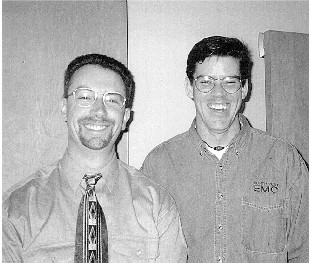
Rob Steinle of Boeing and James Tilley of Northwest EMC (L-R)
obviously enjoyed the March Seattle Chapter meeting. James recently joined
Northwest EMC in Bothell, Washington and is a new Seattle Chapter recruit!
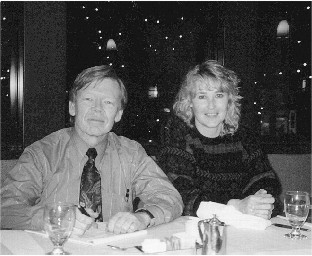
Seattle Symposium Committee is hard at work planning the best
symposium ever this August. Pictured at a recent committee meeting are
Rick Covill and Diane Heidlebaugh, both of Boeing. Rick is the committee
secretary and Diane is handling local arrangements.

Also lending a hand on the Seattle Symposium Committee are
(L-R) Rob Steinle of Boeing, Jeannie Olson of Kalmus, and Bill Price of Boeing.
Rob is Treasurer, Jeannie handles Exhibits, and Bill Price is Vice-Chairman.

Attending to details on the Seattle Symposium Committee are (L-R)
Bill Gjertson
of Boeing who is the Committee Chairman, Bill Hall of William P. Hall
Contract Services who is handling exhibits, and Marianne Gjerston who
will ensure the companions have a great time in Seattle.
The Seattle EMC chapter is actively involved in several upcoming EMC events including the one day tutorial entitled “Introduction to EMC” with Clayton Paul on August 1 (register now on-line at www.acmetesting.com) and, of course, the 1999 IEEE International Symposium on EMC, August 2-6, at the Washington State Convention and Trade Center (visit the website https://www.seattleemc99.org for more information). Plans are also being made to schedule monthly speakers for the September 99 to May 00 chapter calendar. There’s never a dull moment in Seattle! Drop in and visit the chapter if you come to Seattle. Check the schedule of events on the chapter’s web page at https://home1.gte.net/joecool/ieee/.
Brodie Pedersen reports that the Twin Cities EMC Chapter held their annual half-day EMC Workshop on March 10, 1999. The event was hosted by Program Chair and IEEE EMC President, Dan Hoolihan. Robert Rynkiewicz gave a presentation on “Low Noise Switching Regulators.” Edwardo Villaseca presented “FDTD Analysis to Predict EMC.” Dennis Swanson presented “A Comparison of the ‘e-mark’ to CE-mark’ Approval Process for Vehicles and Mobile Machines.” Brodie Pedersen presented “A Comparison of the Current 60601-1-2 to the New Draft.” And last but definitely not least, Dan Hoolihan gave a talk on “ISO Guide 25 General Lab Requirements.” The speakers also shared other bits of information and answered questions following each talk and over beverages and cookies provided by our sponsors.
The chapter would like to thank the sponsors of this event: Jerry Zander of Murnco, Joel Larsen of Hewlett Packard, Garry Keaster of Chomerics, Bob Karr of Instrument Specialties, Scott Sandstrom of Comtel Midwest, and Bob Patrick of EIA. Much fun was had by all. Everyone enjoyed Dan’s jokes and the fellowship that we all share in practicing our ‘Black Magic’. Just remember, waving the rubber chicken over an EMC problem does no good until after midnight.